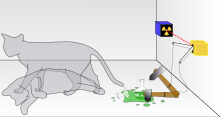
Schrödinger's cat is a thought experiment, usually described as a paradox, devised by Austrian physicist Erwin Schrödinger in 1935. It illustrates what he saw as the problem of the Copenhagen interpretation of quantum mechanics applied to everyday objects. The scenario presents a cat that might be alive or dead, depending on an earlier random event. Although the original "experiment" was imaginary, similar principles have been researched and used in practical applications. The Cat paradox is also often featured in theoretical discussions of the interpretation of quantum mechanics. In the course of developing this experiment, Schrödinger coined the term Verschränkung (entanglement).